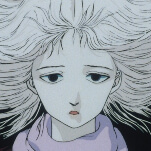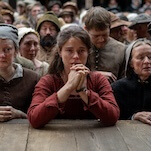Not that the film's setting taps into either: It opens in an unnamed North American coastal location around 1000 A.D., when a Native American woman rescues a Viking child from the wreckage of a Viking ship. Her village elders cluck disapprovingly over his white skin and blue eyes (though due to Pathfinder's ultra-desaturated blue-black palette, he looks pretty much exactly like them), but she shames them into accepting the child into the tribe. Fifteen years later, when the boy (now played by Lord Of The Rings' Karl Urban, and named Ghost, presumably for the color of his still-blue-black-like-everyone-else's skin) has become a man, the Vikings return to wipe out his adoptive tribe, raising the question of which people he really wants to belong to.
Pathfinder is loosely based on the 1987 Oscar-nominated Norwegian film of the same name; that version told a similar story (albeit without the minimally developed child-of-two-worlds subplot), but set it among warring peoples in northern Scandinavia. But the new version's play-by-play could have been cribbed from Apocalypto, from the early idyllic noble-savage interplay to the graphic village massacre to the lengthy running guerilla combat between a lone forest native and a mob of better-armed foreign pursuers. (Improvised spike-traps and a precipitous leap from a waterfall even come into play.) And stylistically, the film looks like a cut-rate 300, all slo-mo decapitations and close-ups on snarling faces, with gritty Conan-style costume design taking the place of hefty CGI intervention. Marcus Nispel, who went from music videos to 2003's Texas Chainsaw Massacre remake to this, puts a heavy-handed directorial stamp on the proceedings, but all the washed-out visual grit and lovely scenery in the world can't hide the thinness of the plot, which mostly amounts to a long chase and a bunch of internecine combat with the slightest dash of fluffy mysticism thrown in. If this uninspired fight-fest had been delayed out of existence, it's unlikely anyone would have missed it.







































